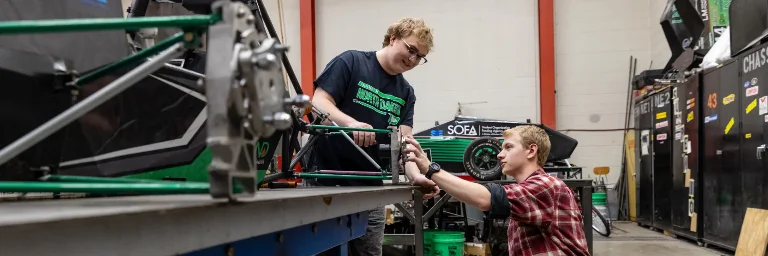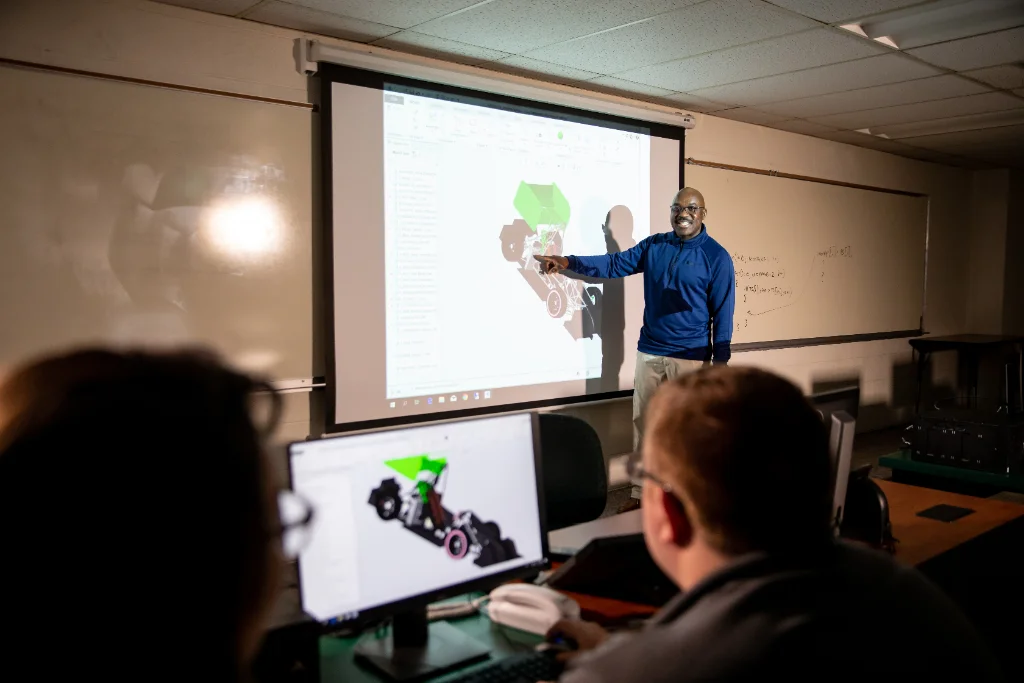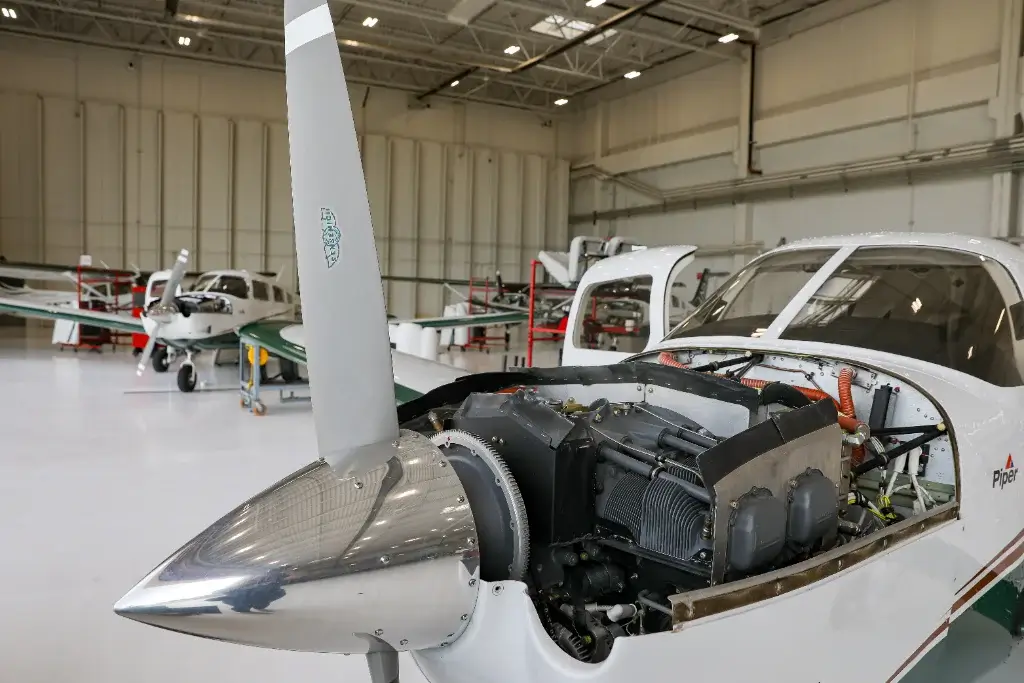
Aerospace Engineer vs. Mechanical Engineer
Engineering intersects innovation and practicality to create the multitude of machines that drive our world forward.
Request Information
However, given the immense diversity of machines and systems, it's impractical to expect a single engineer to master them all. Therefore, engineering has branched out into various specialties, each tailored to tackle distinct challenges.
Today, we'll be comparing aerospace vs. mechanical engineering, examining their unique characteristics and shared traits. So, keep reading and see which path better aligns with your interests and aspirations.
What is an Aerospace Engineer?
Aerospace engineering is the branch of engineering that involves the design, development, testing and production of aircraft, spacecraft, satellites and related systems. The field encompasses various disciplines, including aerodynamics, propulsion, avionics, materials science and structural analysis.
Aerospace engineers are crucial in conceptualizing, designing and manufacturing various aerospace vehicles and systems, ensuring they meet safety, performance and regulatory standards. They work on everything from commercial airplanes and military jets to space shuttles and satellites, pushing the boundaries of technology to explore new frontiers in air and space travel.
What is a Mechanical Engineer?
Mechanical engineering is a field of study that deals with the design, analysis and production of mechanical systems and devices. It covers a wide range of applications, including automotive engineering, robotics, HVAC systems, manufacturing processes and energy systems.
Mechanical engineers are involved in every stage of the product development process, from ideation and design to testing, production and maintenance. They use physics and mathematics principles to develop innovative solutions for various industries, driving technological advancements and improving the efficiency and performance of mechanical systems in numerous applications.
What is the Difference Between Aerospace and Mechanical Engineering?
To gain a clearer understanding of mechanical engineering vs. aerospace engineering and their respective similarities and differences, let's compare these two fields head-to-head across various categories, beginning with education and extending to job outlook and salaries.
Education
Aerospace engineers typically begin their careers by earning a bachelor's degree in Aerospace Engineering or a related field. These programs allow students to explore advanced topics such as orbital mechanics, space vehicle dynamics and avionics systems. Additionally, through engaging in laboratory experiments, design projects and internships, they refine their proficiency in problem-solving, critical thinking and collaborative work.
Similarly, mechanical engineers typically pursue a bachelor's degree in Mechanical Engineering or mechanical engineering technologies. These programs encompass a wide range of subjects, including mechanics of materials, heat transfer and control systems. Students learn to apply engineering principles to design and analyze mechanical systems, such as engines, power plants, robots and medical devices.
Both aerospace and mechanical engineering programs provide students with a strong understanding of engineering fundamentals, empowering them to pursue various career paths in their respective fields as well as licensure as Professional Engineers (PEs), unlocking opportunities for enhanced responsibility and leadership in their careers.
Moreover, pursuing a graduate degree enriches students' educational journey, expands their career prospects and fosters professional growth in both fields. Advanced studies in aerospace engineering, through a master's or Aerospace Sciences Ph.D., enable students to specialize in areas like space systems engineering, aerodynamics or propulsion technology, while a master's and Ph.D. in Mechanical Engineering allows students to explore advanced materials, renewable energy systems or mechatronics.
These specialized areas equip graduates for leadership roles across diverse sectors, further solidifying their impact and influence in engineering.

Skill Set Requirements
Aerospace engineers require a solid grasp of aerodynamics, thermodynamics, structural mechanics, proficiency in computer-aided design (CAD) software and an understanding of aerospace materials and their manufacturing processes.
Mechanical engineers, on the other hand, need a deep knowledge of mechanics, materials science and fluid dynamics, proficiency with computer-aided engineering (CAE) tools and practical experience in working with machinery and mechanical systems.
While technical skills between the two fields differ, both prioritize similar essential soft skills. This emphasis underlines the interdisciplinary essence of engineering and highlights the importance of adaptability.
Key among these soft skills is problem-solving. Engineers, whether focusing on aerospace or mechanical disciplines, use this skill to navigate complex challenges. This might involve crafting an innovative aircraft wing or refining a manufacturing process.
Analytical thinking follows closely. It equips both mechanical and aerospace engineers with the tools to parse data, scrutinize design alternatives and execute informed decisions.
Creativity rounds out these core competencies. It's the engine of innovation, enabling engineers to conceive novel solutions to a broad spectrum of engineering problems. This trio of soft skills—problem-solving, analytical thinking and creativity—collectively underscores the collaborative, innovative spirit essential to the engineering field.
Job Responsibilities
Aerospace engineers oversee the journey of aircraft and aerospace products from conception to testing. They assess project proposals for technical and financial viability, ensuring they meet safety standards and goals. Part of their role involves reviewing designs for compliance with engineering principles, customer needs and environmental regulations.
In a similar vein, mechanical engineers manage the manufacturing process of their designs, focusing on quality and efficiency. They use their expertise to solve problems, incorporating computer-aided design (CAD) tools to refine their solutions.
Both fields require a keen eye for detail in diagnosing issues. Aerospace engineers inspect and address faults in aerospace products, while mechanical engineers analyze equipment failures to recommend fixes. This investigative work underpins their shared commitment to innovation and safety.
Moreover, the development and testing of prototypes is a critical step for both. They analyze test results and adjust designs or systems accordingly, ensuring the final product meets all specifications and standards. This process highlights the iterative nature of engineering work, emphasizing the importance of continuous improvement and precision.
Work Environment
Aerospace engineers typically work in aerospace product and parts manufacturing, engineering services and government agencies. Similarly, mechanical engineers are employed in various sectors, including architectural engineering, machinery manufacturing and transportation equipment manufacturing.
Both types of engineers usually work in office settings, using computers for design, analysis and project management tasks. Occasionally, they may have to travel to meet with clients or partners, especially during project development stages or visit worksites to oversee manufacturing processes, address specific issues or inspect equipment firsthand.
Job Outlook and Salary
Both aerospace and mechanical engineering fields show promising growth prospects. Employment of aerospace engineers is projected to increase by 6% from 2022 to 2032, faster than the average for all occupations. On the other hand, employment of mechanical engineers is expected to grow by 10% during the same period, indicating a much faster growth rate than the average.
Regarding job openings, about 3,800 openings for aerospace engineers and 19,200 openings for mechanical engineers are projected each year, on average, over the decade.
Aerospace engineers usually earn a higher median annual wage in comparison to mechanical engineers. The median annual aerospace engineer salary is $126,880, while for mechanical engineers it is $96,310.
Factors including industry, experience, location and level of education can affect earnings in both professions. Specialized areas or advanced degrees can offer opportunities for higher salaries.

Mechanical Engineering vs. Aerospace Engineering: Which One is Right for You?
Ultimately, the choice between mechanical and aerospace engineering hinges on your interests, career aspirations and personal preferences. It's crucial to take the time to evaluate your options carefully and select a path that aligns with your goals for a fulfilling and rewarding engineering career. Here are some tips to guide you in making an informed decision:
- Explore the job prospects and growth trends in both fields. Consider factors such as the demand for professionals, the industry outlook and the potential for career advancement.
- Reflect on your interests, passions and strengths. Are you more drawn to the design and analysis of mechanical systems and devices or do you have a keen interest in aircraft, spacecraft and aerospace technology? Choose the field that resonates with your interests and inspires you to excel.
- Keep in mind that both mechanical engineering and aerospace engineering offer diverse specializations and career paths. Think about which industry sectors excite you the most and align with your career aspirations.
- Review the educational requirements and curriculum for mechanical and aerospace engineering programs. Assess the coursework, research opportunities and hands-on experiences different universities offer to ensure they match your academic and career objectives.
- Seek guidance from professionals, mentors or career counselors in both fields. Their perspectives and advice can provide valuable guidance in your decision-making process.
- Stay informed about emerging technologies, industry trends and future mechanical and aerospace engineering developments. Consider which field offers greater opportunities for growth, innovation and long-term impact.
Conclusion
All in all, both aerospace and mechanical engineering present opportunities to design, develop and improve the machines and devices that propel our society forward. So, whatever path you decide to take, know that you are choosing a field with immense potential to drive innovation and make a meaningful impact.
Ready to begin your engineering journey? Start with our engineering degrees today and soar to new heights in both knowledge and earnings.
FAQs
Yes, aerospace engineers can transition to mechanical engineering roles and vice versa, although adapting to specific job requirements and industry standards may require additional training or education.
A common misconception is that aerospace engineering only involves space-related projects, while mechanical engineering is limited to machinery. In reality, both fields encompass a wide range of industries and applications beyond these stereotypes.